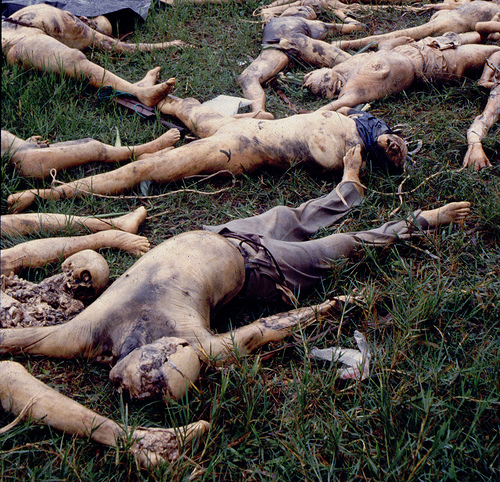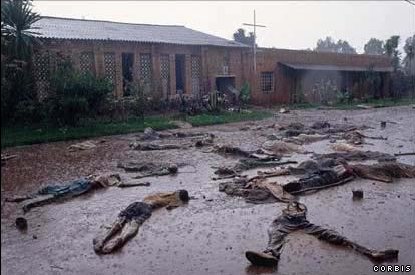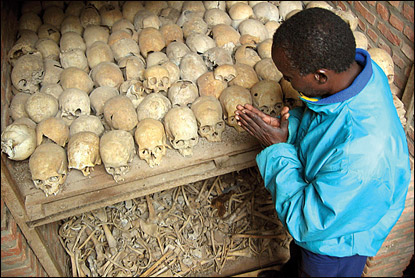I crossed the border into Rwanda and promptly threw up. I had eaten a nice breakfast of ham and cheese omelet, toast, fruit and tea. But within hours I felt queasy and just past immigration, I had to pull over and puke on the side of the road. Not a great start to Rwanda. Amazingly, there were no witnesses. Rwanda is the most densely populated country in Africa and most of time there are people everywhere.
Rwanda is called the Land of a Thousand Hills, and it’s true. There is not a flat spot anywhere. I struggled up some 800 m high hills and realized how out of shape I had become. I have not climbed such hills since the highlands of Ethiopia.
But I wanted to visit Rwanda for a couple reasons. One, it is probably the only French speaking country I will visit in Africa (although bad news for the francophones: they decided recently to teach English instead of French–sorry). The other reason was that I am interested in the horrific genocide that took place here in 1994. Between April and June 1994, an estimated 800,000 Rwandans were killed in the space of 100 days. More on that later.
First, a few photos of the Rwandan countryside. In the Land of Thousand Hills, they must use terracing to create flat spaces to grow their crops. Here’s a typical sight. They must have strong legs from all the climbing.
On the way to Kigali I passed through many towns that had signs erected like one.
It says something like, “the people of Rulindo pledge to stop genocide at its roots.”
Some views of Kigali. I liked the movement in this shot. It was unintentional–the photo was taken at dusk. But it expresses the hustle and bustle of a big city.
A woman and child begging for money on the streets of Kigali.
The Really Bad Stuff
It was exactly 15 years ago this month that extremist Hutu soldiers and militia began an unbelievable campaign of genocide against the minority Tutsi in Rwanda. I’ve done a bit of research of the subject and so bear with me while I try to summarize it. If you are not interested in the genocide you can skip ahead to the photos.
Roots of the conflict
Rwanda is comprised of three ethnic groups, the Hutu, who make up about 84%, the Tutsi, about 15%, and the Twa pygmies about 1%. At the Berlin Conference of 1884, where the European powers divided up Africa among themselves, Rwanda was awarded to Germany, but after WWI, the area was given to Belgium. Before that time the Hutu and Tutsi lived more or less peacefully together. Sure there were occasional tribal squabbles, but there was frequent intermarriage, they spoke the same language and shared many of the same customs. Physically, though, the Hutu were short and squat while the Tutsi were tall and angular.
The Belgians took over Rwanda in 1916 and immediately began to exploit the ethnic difference. This “divide and conquer” strategy was common by the colonial powers. They deliberately tried to set different tribes against each other to prevent a common front.
The first thing they did was to classify people by ethnic group. This was not always easy. What ethnic group did the child of a Hutu father and Tutsi mother belong to? In many cases the Belgians just randomly assigned people to one group or the other based on their appearance or social status. Then, they issued identity cards which indicated which ethnic group each person belonged to. This aided the genocide which was to come.
The Belgians considered the Tutsis to be superior to the Hutus. Not surprisingly, the Tutsis welcomed this idea, and for the next 20 years they enjoyed better jobs and educational opportunities than their neighbors.
Resentment among the Hutus gradually built up, though, culminating in a series of riots in 1959. More than 20,000 Tutsis were killed, and many more fled to the neighboring countries of Burundi, Tanzania and Uganda.
In 1962 Belgium relinquished power and granted Rwanda independence. By this time Belgium had decided to support the Hutu and Rwanda’s first president was Hutu. Over subsequent decades, the Tutsis were portrayed as the scapegoats for every crisis.
In 1973 Juvenal Habyarimana, another Hutu, became president in a coup and for awhile things settled down and Rwanda enjoyed relative peace.
The situation in Rwanda had been influenced to a great extent by events in Burundi. Both countries had a Hutu majority, yet an army-controlled Tutsi government in Burundi persisted for decades.
Another seven years of sporadic violence in Burundi (from 1965 – 1972) existed between the Hutus and Tutsis. In 1969 another purge of Hutus by the Tutsi military occurred. Then, a localized Hutu uprising in 1972 was fiercely answered by the Tutsi-dominated Burundi army in the largest Burundi genocide of Hutus, with a death toll nearing 200,000.
This violence led to another wave of cross border Hutu refugees into Rwanda. Now there were large numbers of both Tutsi and Hutu refugees throughout the region, and tensions continued to mount.
In 1988, Hutu violence against Tutsis throughout northern Burundi again resurfaced, and in response the Tutsi army massacred approximately 20,000 more Hutu. Again thousands of Hutu were forced into exile into Tanzania and Congo to flee another genocide of Hutu.
Meanwhile, the many Rwandan Tutsi refugees who had fled into Uganda had formed an effective fighting force called the Rwanda Patriotic front (RPF) led by current president Paul Kagame. Their aim was to overthrow Habyarimana and secure the right to return to their homeland. Habyarimana chose to exploit this threat as a way to bring dissident Hutus back to his side, and Tutsis inside Rwanda were accused of being RPF collaborators.
Civil War
In 1990, the Tutsi-dominated RPF invaded Rwanda from Uganda. Some members allied with the military dictatorship government of Habyarimana responded in 1993 to the RPF invasion with a radio station that began anti-Tutsi propaganda and with programs against Tutsis, whom it claimed were trying to re-enslave the Hutus.
The situation worsened when the first elected Burundian president, Melchior Ndadaye, a Hutu, was assassinated by the Burundian Tutsi-dominated army in October 1993. In Burundi, a fierce civil war then erupted between Tutsi and Hutu and tens of thousands, both Hutu and Tutsi, were killed in this conflict.
Between 1990 and 1994 Hutu extremists in the Rwandan government and military had carefully planned how to implement the final solution to the Tutsi “problem”. Their stated goal was to exterminate all Tutsis in Rwanda. To this end they recruited and trained thousands of poor youth from the country and supplied them with machetes, hand grenades and guns. The most notorious of these was the militia group called the Interahamwe (meaning those who attack together).
Meanwhile the civil war between the Rwandan military and the RPF continued. Then came the spark. On April 6, 1994, the president of Rwanda, Habyarimana, was assassinated when his jet was shot down. Exactly who killed the president has not been established. Whoever was behind the killing, its effect was both instantaneous and catastrophic. Extremist Hutu began to implement their deadly, well organized campaign of genocide.
Genocide
In Kigali, the presidential guard immediately initiated a campaign of retribution. Leaders of the political opposition were murdered, and almost immediately, the slaughter of Tutsis and moderate Hutus began.
Within hours, recruits were dispatched all over the country to carry out a wave of slaughter. Encouraged by the presidential guard and radio propaganda, the Interahamwe was mobilized. At its peak, this group was 30,000-strong.
Soldiers and police officers encouraged ordinary citizens to take part. In some cases, military personnel forced Hutu civilians to murder their Tutsi neighbors, and even family members in some cases. Participants were often given incentives, such as money or food, and some were even told they could appropriate the land of the Tutsis they killed.
Rwanda became a bloodbath. Gangs of soldiers and Interahamwe militia roamed the countryside at will, slaughtering entire families of Tutsi wherever they were found. Most of the victims were killed in their villages or in towns, often by their neighbors and fellow villagers. The militia members typically murdered their victims by hacking them with machetes or beating them with clubs, although some army units used rifles. The victims were often found hiding in churches and school buildings, where Hutu gangs massacred them. Ordinary citizens were called on by local officials and government-sponsored radio to kill their neighbors, and those who refused to kill were often killed themselves. One survivor claimed, “Either you took part in the massacres or you were massacred yourself.”
Other groups of killers set up roadblocks, checking the ID cards of passersby. Any Tutsi found were killed on the spot. In one town about 500 Tutsi sought refuge in a catholic church. The Interahamwe arrived and slaughtered them. Only two people survived.
The savagery was incomprehensible. Men, women, babies, and the elderly were hacked to death with machetes. Many were left to bleed to death from their injuries. Some were burned or buried alive. Others were bound and thrown into rivers. Fetuses were gouged out of pregnant women. Bodies and body parts littered the streets, causing an awful stench. Dogs ate the flesh of the corpses. Garbage trucks had to be brought in to dispose of the bodies in mass graves. 5000 bodies a day were seen floating down one of the main rivers in Rwanda.
Rape and sexual assault was also used frequently as a weapon. Families were forced to watch soldiers and Interahamwe militia gang rape the women and girls before everyone was hacked to pieces.
In all, an estimated 800,000 to one million Tutsi and moderate Hutu were killed in the space of just three months. This is almost 10,000 people killed every single day during this period.
The Rwandans were largely left alone by the international community. A small UN peacekeeping force with a narrow mandate was denied by headquarters from intervening. After the recent embarrassing events in Somalia the UN and in particular the US, did want to be come embroiled in another African morass. It is a shame that with a little more resolve, a few troops and some weapons, a half a million innocent people could have been saved.
The Aftermath
Finally, in July, 1994 the RPF captured Kigali. The government collapsed and the RPF declared a ceasefire. As soon as it became apparent that the RPF was victorious, an estimated two million Hutus fled to Zaire (now the Democratic Republic of Congo). Mr. Kagame became president.
He seems to be doing a good job. He has abolished the ID cards and consistently supports the notion that there are no Tutsi or Hutu, only Rwandans. Of course, everyone knows which tribe the belong to, but if the government can continue to minimize tribal distinctions perhaps some peace can finally come to this beleaguered little country.
In Kigali they have created a Genocide Memorial museum which describes the events that took place in chilling detail. It also has exhibitions of other terrible genocides that have taken place in the 20th century—The Armenians in 1915, the Holocaust in Nazi Germany, the Khmer Rouge in Cambodia (although in my mind, technically not a genocide), and the Balkan conflict between Serbia and its neighbors.
Here are some photos. Warning—some are quite graphic, but I think it is important to show them.
The entrance to the museum. There was no word for genocide in the local language, kinyarwanda. It had to be created.
These are some of the dead killed in a church.
Typical sights during the massacre.
Skulls of the dead.
One room had thousands of photos of those killed provided by surviving relatives and friends.
photos of children who were killed.
There was a video which played some horrific scenes. I tried to photograph some of them.
One of the most moving sections showed large photos of children who had perished, along with some personal details.
Name: Nadia Chanelle Ruterana Kanyage
Age: 8
Favorite sport: Jogging with her father
Favorite sweet: Chocolate
Favorite drink: Milk
Favorite song: My Native Land which God Chose for Me.
Enjoyed: TV and Music
Cause of death: Hacked by machete
Name: Patrick Gashugi Shimirwa
Age: 5
Favorite sport: Riding his bicycle
Favoriet food: Chips, meat and eggs
Best friend: Alliane, his sister
Behavior: A quiet, well behaved boy
Cause of death: Burned alive in the Gikondo chapel
I left the museum in a somber mood. How, I wondered, could people behave so savagely? How can people harbor such hatred toward others that they could kill so many in such brutal ways? Were these people violent psycopaths who concealed their true nature prior to the massacre and pretended to live normal lives, waiting for a chance to become brutal killers? Or were they normal people who got caught up in mob mentality and peer pressure, temporarily changing them into beasts? If the latter is correct, could all of us be susceptible to such behavior, under the right circumstances? I can’t imagine a situation where I could perpetrate such awful acts. I mean, who do I hate that much that I could kill them? I am annoyed sometimes by my snobby South Beach neighbors, but I don’t think I could take up a machete and hack them to pieces. But you never know. There’s a great line in the movie Chinatown that touches on this:
Noah Cross: See, Mr. Gitts, most people never have to face the fact that, at the right time and the right place, they’re capable of… anything!
Were these people disaffected because of decades of Tutsi favoritism? Was it like the Balkans, where people said, “ your great-grandfather killed my great-grandfather, therefore I must kill you.”
I guess the question has been asked many times before. Why did the Nazis hate the Jews so much? Why did the Turks kill the Armenians? Why does the KKK exist in America?
The museum also poses another question: can future genocides be prevented? The answer clearly is yes. A genocide is not a spontaneous outbreak of killing. It must be planned, coordinated and organized. For four years in Rwanda people were recruited and trained to kill. Weapons had to be procured and lists of people drawn up. The killing has to be organized. Cells were established throughout the country with each group responsible for killing in their area.
All this takes time. People talk, word gets out. There is opportunity for the international community to discover what is going on and to intervene. We just need the resolve to do it.
There was plenty of evidence that a genocide was probable in Rwanda. Even the CIA issued a report saying that up to 500,000 Tutsi could be killed. This was before the genocide started, and was the reason why the US sent in a team to evacuate all 257 Americans in Rwanda in April, 1994. The UN, UK, France and Belgium had loads of evidence—outright statements from military leaders, stockpiles of weapons, “death lists”, and radio propaganda—that clearly showed the intentions of the government towards the Tutsi. People knew what was possible, but no one wanted to get involved.
Innocent civilians in Rwanda were abandoned in their time of desperate need. Nobody seemed to care about a poor small African country. Not the UN, not the great powers of the world, not the media. Romeo Dallarie of Canada, head of the UN peacekeeping force, repeatedly asked for support and warned of the impending catastrophe. He was ignored or brushed off. Later, former US president Bill Clinton claimed he did not realize the extent of the violence until it was too late. The UK’s John Major also claimed ignorance. The truth is people knew but they just did not care. The leaders of the US, UK, France, Begium and the UN secretariat must surely take some responsibility for the tragedy.


